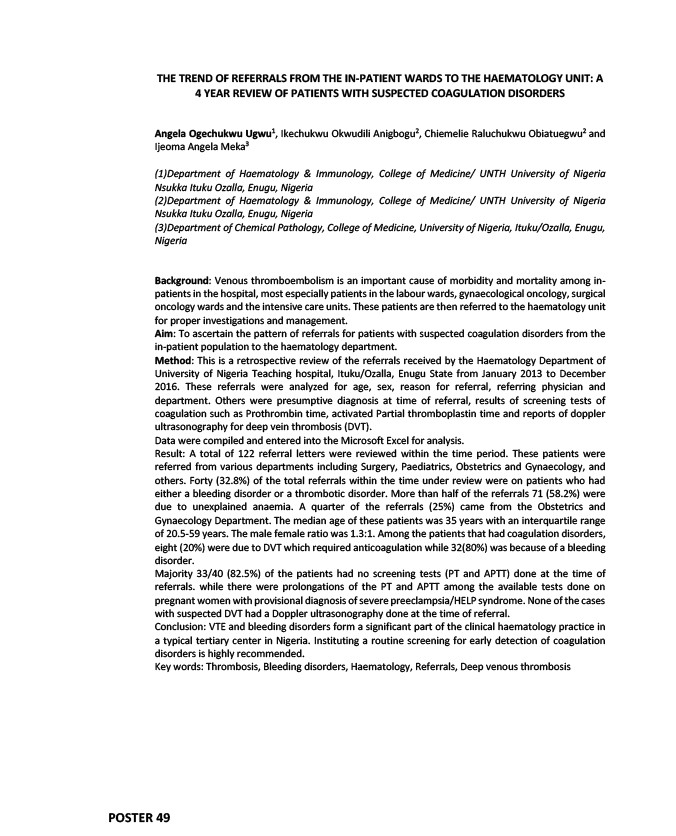
THE TREND OF REFERRALS FROM THE IN-PATIENT WARDS TO THE HAEMATOLOGY UNIT: A
POSTER 49
4 YEAR REVIEW OF PATIENTS WITH SUSPECTED COAGULATION DISORDERS
Angela Ogechukwu Ugwu1, Ikechukwu Okwudili Anigbogu2, Chiemelie Raluchukwu Obiatuegwu2 and
Ijeoma Angela Meka3
(1)Department of Haematology & Immunology, College of Medicine/ UNTH University of Nigeria
Nsukka Ituku Ozalla, Enugu, Nigeria
(2)Department of Haematology & Immunology, College of Medicine/ UNTH University of Nigeria
Nsukka Ituku Ozalla, Enugu, Nigeria
(3)Department of Chemical Pathology, College of Medicine, University of Nigeria, Ituku/Ozalla, Enugu,
Nigeria
Background: Venous thromboembolism is an important cause of morbidity and mortality among in-
patients in the hospital, most especially patients in the labour wards, gynaecological oncology, surgical
oncology wards and the intensive care units. These patients are then referred to the haematology unit
for proper investigations and management.
Aim: To ascertain the pattern of referrals for patients with suspected coagulation disorders from the
in-patient population to the haematology department.
Method: This is a retrospective review of the referrals received by the Haematology Department of
University of Nigeria Teaching hospital, Ituku/Ozalla, Enugu State from January 2013 to December
2016. These referrals were analyzed for age, sex, reason for referral, referring physician and
department. Others were presumptive diagnosis at time of referral, results of screening tests of
coagulation such as Prothrombin time, activated Partial thromboplastin time and reports of doppler
ultrasonography for deep vein thrombosis (DVT).
Data were compiled and entered into the Microsoft Excel for analysis.
Result: A total of 122 referral letters were reviewed within the time period. These patients were
referred from various departments including Surgery, Paediatrics, Obstetrics and Gynaecology, and
others. Forty (32.8%) of the total referrals within the time under review were on patients who had
either a bleeding disorder or a thrombotic disorder. More than half of the referrals 71 (58.2%) were
due to unexplained anaemia. A quarter of the referrals (25%) came from the Obstetrics and
Gynaecology Department. The median age of these patients was 35 years with an interquartile range
of 20.5-59 years. The male female ratio was 1.3:1. Among the patients that had coagulation disorders,
eight (20%) were due to DVT which required anticoagulation while 32(80%) was because of a bleeding
disorder.
Majority 33/40 (82.5%) of the patients had no screening tests (PT and APTT) done at the time of
referrals. while there were prolongations of the PT and APTT among the available tests done on
pregnant women with provisional diagnosis of severe preeclampsia/HELP syndrome. None of the cases
with suspected DVT had a Doppler ultrasonography done at the time of referral.
Conclusion: VTE and bleeding disorders form a significant part of the clinical haematology practice in
a typical tertiary center in Nigeria. Instituting a routine screening for early detection of coagulation
disorders is highly recommended.
Key words: Thrombosis, Bleeding disorders, Haematology, Referrals, Deep venous thrombosis